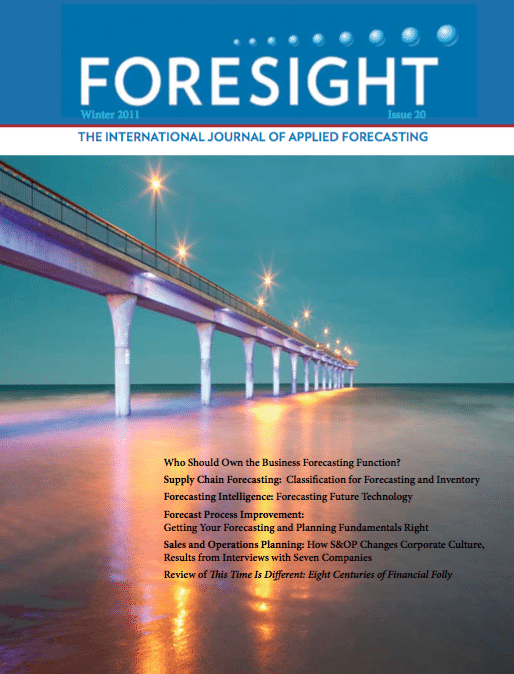FORESIGHT, Issue 20
$45.00
Description
Winter 2011 Issue
Articles
-
- Classification for Forecasting and Inventory by Aris Syntetos, John Boylan and Ruud Teunter
ABC classifications are commonly used to streamline a large number of SKUs into fewer, more manageable categories. As Aris, John, and Ruud explain, this classification may be useful for inventory control, but it does not provide much help in the selection of appropriate forecasting methods. The authors demonstrate a need for a classification that accounts for demand patterns and customer characteristics. - Forecasting Future Technology by Roy Pearson
In Foresight’s Summer 2008 issue, I wrote a piece called “Looking at Tomorrow Today: The What, Why, and How of Futuring for Forecasters.” The article described methodologies for developing foresight about future changes, in order to anticipate shifts or breaks and their probable causes before your forecast errors become a cascade. I suggested setting aside one morning each quarter to review and brainstorm about possible “ifs” and what some of these would mean for your business. Identifying relevant “ifs” is worthwhile, even if the “whens” are currently unpredictable. Futuring can show you relevant “ifs” that can cause breaks with the past, and help you identify warning signals for impending “whens.” - Getting Your Forecasting and Planning Fundamentals Right by Alec Finney and Martin Joseph
In their previous Foresight article (Winter 2009), Alec Finney and Martin Joseph described the Forecasting Mantra, the elements of which guide the proper creation and presentation of the forecast. Now they employ the Mantra as a basis for an audit of an organization’s forecasting performance. The audit reveals problems with the process, enables the prioritizing of new investments in process improvement, and helps a company avoid overspending. - How S&OP Changes Corporate Culture: Results from Interviews with Seven Companies by John Mello and Bob Stahl
John Mello and Bob Stahl have each contributed many publications about the Sales and Operations Planning process and its dependence on changes in corporate culture. For this article, they have teamed up to examine the cultural impact of S&OP in seven companies, interviewing individuals who were present before and after S&OP implementations. The interview results reveal remarkable changes in corporate culture and greater satisfaction with corporate performance. - Peter Kennedy: In Memoriam by Antonio Garcia-Ferrer
Professor Emeritus Peter Kennedy of Simon Fraser University in Vancouver passed away unexpectedly on August 30, 2010. He is best known for his book A Guide to Econometrics, a remarkable distillation of highly technical concepts into straightforward principles for modeling and forecasting. - Who Should Own the Business Forecasting Function? by Joe Smith and Simon Clarke
Where in an organization should the forecasting function be located? This most fundamental question is often overlooked, and there are organizations that have stumbled into a preliminary placement without having really thought through the options. In this first installment of their new column, Joe Smith and Simon Clarke offer their prescriptions and the arguments behind them. As you will see, they agree that minimizing functional bias is the most important consideration, but they recommend quite different structural approaches to accomplish this. - Book Review by David Orrell
This Time Is Different: Eight Centuries of Financial Folly by Carmen M. Reinhart and Kenneth S. Rogoff
- Classification for Forecasting and Inventory by Aris Syntetos, John Boylan and Ruud Teunter







